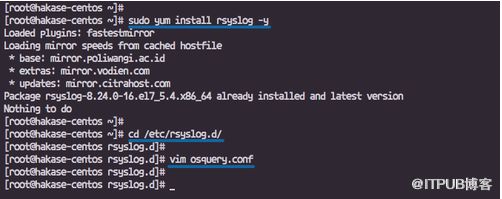如何在Linux上使用Osquery设置文件完整性监控(FIM)
Osquery是一个SQL驱动操作系统检测和分析工具,它由Facebook创建,支持像SQL语句一样查询系统的各项指标,可以用于OSX和Linux操作系统。
Osquery是一个多平台软件,可以安装在Linux,Windows,MacOS和FreeBSD上。它允许我们使用基于SQL的查询来处理操作系统的配置文件、性能、安全检查等。
在本教程中,我们将向您展示如何使用Osquery设置文件完整性监控(FIM)。我们使用的linux操作系统是Ubuntu 18.04和CENTOS 7。
条件
-
Linux(Ubuntu或CentOS)
-
Root权限
-
完成了第一个osquery指南
步骤一:在Linux服务器上安装osquery
Osquery为所有的安装平台提供了自己的存储库,我们要做的第一步是从官方的osquery存储库安装osquery包。
在Ubuntu上
将osquery密钥添加到系统。
Export OSQUERY_KEY = 1484120AC4E9F8A1A577AEEE97A80C63C9D8B80B
sudo apt-key adv --keyserver keyserver.ubuntu.com --recv-keys $ OSQUERY_KEY
添加osquery存储库并安装。
sudo add-apt-repository'deb [arch = amd64] https://pkg.osquery.io/deb deb
main'sudo apt install osquery -y
在CentOS上
将osquery密钥添加到系统。
curl -L https://pkg.osquery.io/rpm/GPG | sudo tee / etc / pki / rpm-gpg / RPM-GPG-KEY-osquery
添加并启用osquery存储库,然后安装该软件包。
Sudo yum-config-manager --add-repo https://pkg.osquery.io/rpm/osquery-s3-rpm.repo
sudo yum-config-manager --enable osquery-s3-rpm
sudo yum install osquery -y
等待安装所有软件包
注意: 如果您收到关于yum-config-manager命令的错误消息。
sudo: yum-config-manager: command not found
安装'yum-utils'包。
yum -y install yum-utils
步骤二:启用Osquery的Syslog Consumption
Osquery提供了一些功能,可以使用Apple system Log (ASL)读取Apple MacOS上的系统日志,对于Linux则使用syslog。
在此步骤中,我们将通过rsyslog启用osquery的syslog consumption。
在Ubuntu上
使用如下apt命令安装rsyslog
sudo apt install rsyslog –y
在CentOS上
使用如下yum命令安装rsyslog包。
sudo yum install rsyslog -y
安装完成后,转到'/etc/rsyslog.d'目录并创建一个新的配置文件osquery.conf。
cd /etc/rsyslog.d/
vim osquery.conf
然后粘贴如下配置
template(
name =“OsqueryCsvFormat”
type =“string”
string =“%timestamp ::: date-rfc3339,csv%,%hostname ::: csv%,%syslogseverity ::: csv%,%syslogfacility-text ::: csv%,%syslogtag ::: csv%,%msg ::: csv%\ n“
)
*。* action(type =”ompipe“Pipe =”/ var / osquery / syslog_pipe“template =”OsqueryCsvFormat“)
保存并退出
步骤三: osquery基本配置
osquery默认配置是'osquery.conf',通常位于'/ etc / osquery'目录中。
在这一步,我们将了解osquery配置组件,创建自定义osquery配置,然后将osqueryd部署为服务。
格式化为JSON 文件的osquery 配置包含如下规范:
-
Options:osqueryd CLI命令的一部分,它决定应用程序的启动和初始化。
-
Schedule:将计划的查询名称的Flow定义到查询详情。
-
Decorators:用于向结果和快照日志添加额外的“decorations”。
-
Packs:一组调度查询
-
More:File Path, YARA, Prometheus, Views, EC2, Chef Configuration。
转到'/ etc / osquery'目录并创建一个新的自定义配置'osquery.conf'。
cd / etc / osquery /
vim osquery.conf
粘贴以下配置。
{
“options”:{
“config_plugin”:“filesystem”,
“logger_plugin”:“filesystem”,
“logger_path”:“/ var / log / osquery”,
“disable_logging”:“false”,
“log_result_events”:“true” ,
“schedule_splay_percent”:“10”,
“pidfile”:“/ var / osquery / osquery.pidfile”,
“events_expiry”:“3600”,
“database_path”:“/ var / osquery / osquery.db”,
“verbose” :“false”,
“worker_threads”:“2”,
“enable_monitor“:”true“,
”disable_events“:”false“,
”disable_audit“:”false“,
”audit_allow_config“:”true“,
“host_identifier”:“hakase-labs”,
“enable_syslog”:“true”,
“syslog_pipe_path”:“/ var / osquery / syslog_pipe”,
“force”:“true”,
“audit_allow_sockets”:“true”,
“schedule_default_interval” :“3600”
},
“schedule”:{
“crontab”:{
“query”:“SELECT * FROM crontab;”,
“interval”:300
},
“system_info”:{
“query”:“SELECT hostname,cpu_brand, physical_memory FROM system_info;“,
“interval”:3600
},
“ssh_login”:{
“query”:“SELECT username,time,host FROM last WHERE type = 7”,
“interval”:360
}
},
“decorators”:{
“load”:[
“SELECT uuid AS host_uuid FROM system_info;”,
“SELECT user AS username FROM logged_in_users ORDER BY time DESC LIMIT 1;”
]
},
“packs”:{
“osquery-monitoring”:“/ usr / share / osquery / packages / osquery -monitoring.conf”
}
}
保存并退出
注意:
-
我们使用'filesystem'作为配置文件和记录器插件
-
定义'/ var / log / osquery'目录的记录器路径
-
将SysLog-PIP启用到'/Va/ysLogy/SySalpJixBube文件中。
-
在调度程序中,我们定义了三个查询来检查crontab, system info, 和ssh login.
-
启用名为“osquery-monitoring”的osquery包,并将该包放置在'/Ur/Stuts/OsQue/Pokes’目录中。
启动osqueryd daemon service(使其在每次系统引导时启动)。
systemctl start osqueryd
systemctl enable osqueryd
重新启动rsyslog服务
systemctl restart rsyslog
osquery基本配置完成。
步骤四:使用osquery配置文件完整性监控(FIM)
Osquery使用Linux和FSEvents提供Linux和MacOS Darwin上的文件完整性监控。简单地的说,它使用'file_path'检测定义目录上的任何一个文件的更改,然后将所有活动存储到file_events表中。
在这个步骤中,我们将配置Osquery来使用自定义FIM包监视重要目录,如HOST、SSH目录,以及tmp和www web根目录等。
转到“/usr/share/osquery/packs”目录,创建一个新的软件包配置文件“fim.conf”。
cd / usr / share / osquery / packs
vim fim.conf
配置如下:
{
"queries": {
"file_events": {
"query": "SELECT * FROM file_events;",
"removed": false,
"interval": 300
}
},
"file_paths": {
"homes": [
"/root/.ssh/%%",
"/home/%/.ssh/%%"
],
"etc": [
"/etc/%%"
],
"home": [
"/home/%%"
],
"tmp": [
"/tmp/%%"
],
"www": [
"/var/www/%%"
]
}
}
保存并退出
返回到 '/etc/osquery'配置目录,编辑osquery.conf文件。
cd /etc/osquery/
vim osquery.conf
在 'packs' 中添加文件完整性监控包配置。
"packs": {
"osquery-monitoring": "/usr/share/osquery/packs/osquery-monitoring.conf",
"fim": "/usr/share/osquery/packs/fim.conf"
}
保存并退出,然后重新启动osqueryd服务。
systemctl restart osqueryd
注意: 继续使用JSON linter“ http://jsonlint.com/ ” 检查JSON配置文件,确保没有错误。
步骤五:测试
我们将通过在定义的目录“home”和“www”上创建一个新文件来测试文件完整性监控包。
转到“/var/www/”目录,创建一个名为“howtoforge.md”的新文件。
cd /var/www/
touch howtoforge.md
转到'/ home / youruser /'目录并创建一个名为'hakase-labs.md'的新文件。
cd / home / vagrant /
touch hakase-labs.md
使用实时交互模式osqueryi 和osquery 的结果日志检查所有日志监控。
osqueryi
运行下面的osqueryi命令。
osqueryi --config-path /etc/osquery/osquery.conf
检查'file_events'表中文件更改的所有日志。
对于全局更改。
select * from file_events;
对于'home'目录。
select target_path, category, action, atime, ctime, mtime from file_events WHERE category="home";
对于'www' web root目录。
select target_path, category, action, atime, ctime, mtime from file_events WHERE category="www";
osqueryd 结果日志
转到'/ var / log / osquery'目录,您将获得'osqueryd.results.log'文件。
cd / var / log / osquery /
ls -lah osqueryd.results.log
使用'grep'命令筛选osquery日志。
grep -rin howtoforge.md osqueryd.results.log
grep -rin hakase-labs.md osqueryd.results.log
你将看到所有已创建的文件信息
使用osquery在Linux Server Ubuntu和CentOS上安装和配置文件完整性监控(FIM)已成功完成。
来自 “ ITPUB博客 ” ,链接:http://blog.itpub.net/31542119/viewspace-2213905/,如需转载,请注明出处,否则将追究法律责任。
转载于:http://blog.itpub.net/31542119/viewspace-2213905/







